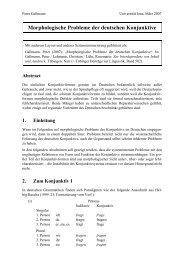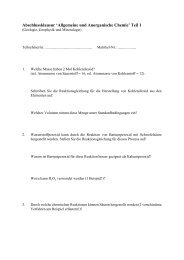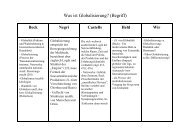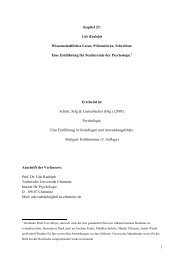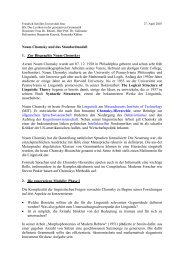Analytica Chimica
Analytica Chimica
Analytica Chimica
Create successful ePaper yourself
Turn your PDF publications into a flip-book with our unique Google optimized e-Paper software.
<strong>Analytica</strong> <strong>Chimica</strong> Acta 414 (2000) 181–187<br />
Effect of the polymer matrix on the response of optical sensors for<br />
dissolved aliphatic amines based on the chromoreactand ETH T 4001<br />
Gerhard J. Mohr ∗ , Tomas Nezel, Ursula E. Spichiger-Keller<br />
Centre for chemical Sensors, ETH Technopark, Technoparkstrasse 1, CH-8005 Zurich, Switzerland<br />
Received 5 November 1999; accepted 28 January 2000<br />
Abstract<br />
The absorbance-based chromoreactand 4-(N, N-dioctylamino)-4 ′ -trifluoroacetylazobenzene (ETH T 4001) has been investigated<br />
in different polymer matrices for the optical sensing of dissolved aliphatic amines. Sensor layers composed of ETH T<br />
4001 and different polymer materials generally show a decrease in absorbance at around 500 nm and an increase in absorbance<br />
at around 420 nm wavelength upon exposure to dissolved aliphatic amines. This change in absorbance is caused by<br />
a conversion of the trifluoroacetyl group of the reactand into a hemiaminal or a zwitterion.<br />
Several polymer materials have been screened for their use in optical amine sensing, such as plasticized poly(vinyl chloride)<br />
(PVC), copolymers of acrylates, polybutadiene (PBD), and silicone. The choice of the polymer affects the sensitivity of the<br />
sensor layer, which is generally in the mM range for 1-butylamine, and the response time, which lies in the range of 10–30 min.<br />
Furthermore, the polarity of the polymer matrix has a strong influence on the diol formation caused by conditioning in water,<br />
and on the absorbance maximum of the solvatochromic reactand. However, the selectivity of the sensor layers for primary,<br />
secondary and tertiary amines is nearly unaffected by the polymer matrix. Thus, while it is possible to vary sensitivity towards<br />
amines and humidity by choosing the appropriate polymer matrix, it is not possible to modify the sensor’s selectivity within<br />
different amines. © 2000 Elsevier Science B.V. All rights reserved.<br />
Keywords: Aliphatic amines; Optical sensors; ETH T 4001; Chromoreactand; Polymers; Plasticizers; Humidity<br />
1. Introduction<br />
Recently, a new class of indicator dyes for optical<br />
sensing has been presented. These dyes respond to<br />
nucleophilic analytes by performing reversible chemical<br />
reactions. As a consequence of these chemical reactions,<br />
changes in both absorbance and fluorescence<br />
have been observed. Based on these new indicator<br />
dyes, called ‘chromoreactands’ or ‘fluororeactands’,<br />
∗ Corresponding author. Tel.: +41-1-445-1350;<br />
fax: +41-1-445-1233; www.chemsens.ethz.ch.<br />
E-mail address: gerhard@chemsens.pharma.ethz.ch (G.J. Mohr)<br />
optical sensors for alcohols, amines and humidity have<br />
been developed [1–6]. The optical sensors have mainly<br />
been used by combining a reactand and a catalyst<br />
(if necessary) with the plasticizer dioctylsebacate and<br />
poly(vinyl chloride) (PVC) as the polymer matrix.<br />
Polymers and plasticizers can have a tremendous<br />
effect on the response of both optical and electrochemical<br />
sensors. The lipophilicity and the polarity<br />
of a plasticizer can improve the selectivity of an ISE,<br />
e.g. for magnesium over calcium [7]. Polymers can<br />
exclude ions from permeating the material, while<br />
diffusion constants for gases remain high [8]. The<br />
polymer can enrich or exclude gaseous analytes from<br />
0003-2670/00/$ – see front matter © 2000 Elsevier Science B.V. All rights reserved.<br />
PII: S0003-2670(00)00794-7
182 G.J. Mohr et al. / <strong>Analytica</strong> <strong>Chimica</strong> Acta 414 (2000) 181–187<br />
the membrane. This happens, for instance, in polymer<br />
layers of electronic noses [9], or in the permselective<br />
membranes in gas separation techniques [10]. In order<br />
to be able to fine-tune the selectivity, it is important<br />
to investigate the response behaviour of ligands,<br />
indicators and reactands in different polymer layers.<br />
The present work discusses the effect of polymer<br />
materials on the response of optical sensors for dissolved<br />
aliphatic amines. Not only have plasticized<br />
polymers with significant differences in lipophilicity<br />
and polarity been used, but so too have polymer<br />
materials which are thought to function without any<br />
addition of plasticizers, e.g. silicones or methacrylates.<br />
The sensors have been characterized in terms<br />
of sensitivity, selectivity and response time.<br />
2. Experimental<br />
2.1. Reagents<br />
All the amines used were of analytic reagent grade.<br />
For membrane preparation, PVC (high molecular<br />
weight), tris(2-ethylhexyl)phosphate (TOP), tris(2-ethylhexyl)trimellitate<br />
(TOTM), 2-octyloxybenzonitrile<br />
(CPOE), hexakis-(2,3,6-tri-O-octyl)--cyclodextrine<br />
(-CD) and tetrahydrofuran (THF) were obtained<br />
from Fluka (Buchs, Switzerland). Poly(hexyl methacrylate)<br />
(PHMA), poly(vinyl chloride-co-vinyl acetate-<br />
co-2-hydroxypropyl acrylate) (PVC–OH) with a<br />
content of 81% vinyl chloride, 4% vinyl acetate<br />
and 15% 2-hydroxypropyl acrylate, and cis-transpolybutadiene<br />
(PBD) were obtained from Aldrich<br />
(Buchs, Switzerland). The PHMA was in solution in<br />
toluene and was evaporated to dryness before use.<br />
Ethylene vinyl acetate copolymers with a vinyl acetate<br />
content of 33% (EVA 33) and 45% (EVA 45) came<br />
from Scientific Polymer Products (Ont., NY). Acetic<br />
acid releasing silicone (E4) was from Wacker-Chemie<br />
GmbH (München, Germany). The synthesis and the<br />
optical properties of ETH T 4001 are described in<br />
detail elsewhere [1].<br />
Amine solutions were prepared by dissolving the<br />
appropriate amount of each amine in 0.1 M sodium<br />
hydroxide solution. Due to the high pH of 13.0, the<br />
amines were mainly present in the electrically neutral<br />
form and not in the ammonium form. The correct<br />
amine concentrations were calculated by using the<br />
Henderson–Hasselbach equation and the pK a value of<br />
each amine [4,11].<br />
2.2. Preparation of the sensor layers<br />
Sensor membranes M1–M6 were obtained by dissolving<br />
40 mg of PVC, 80 mg of the respective plasticizer<br />
and 1.0 mg of ETH T 4001 in 0.8 ml of THF (see<br />
Table 1). The sensor membrane M7 was obtained by<br />
dissolving 250 mg of silicone E4 and 1.0 mg of ETH T<br />
Table 1<br />
Composition and absorbance maxima of sensor layers M1–M11, prepared by dissolving the given components and 1 mg of ETH T 4001<br />
in 0.8 ml of THF<br />
Membrane Polymer Plasticizer Absorbance maximum<br />
TFA (nm) a<br />
M1 40 mg PVC 80 mg CPOE 510 434<br />
M2 40 mg PVC–OH 80 mg CPOE 509 432<br />
M3 40 mg PVC 80 mg -CD 485 420<br />
M4 40 mg PVC 80 mg DOS 497 424<br />
M5 40 mg PVC 80 mg TOP 501 423<br />
M6 40 mg PVC 80 mg TOTM 500 427<br />
M7 250 mg E4 – 462 417<br />
M8 65 mg EVA 33 – 494 423<br />
M9 65 mg EVA 45 – 494 423<br />
M10 30 mg PBD – 483 421<br />
M11 120 mg PHMA – 494 424<br />
a Absorbance maximum of the trifluoroacetyl form (TFA) of ETH T 4001 on exposure to dry air.<br />
b Absorbance maximum of the hemiaminal form (HA) of ETH T 4001 on exposure to 0.5 M aqueous 1-butylamine at pH 13.0.<br />
HA (nm) b
4001, M8 by dissolving 65 mg of EVA 33 and 1.0 mg<br />
of ETH T 4001, M9 by dissolving 65 mg of EVA 45 and<br />
1.0 mg of ETH T 4001, M10 by dissolving 30 mg of<br />
PBD and 1.0 mg of ETH T 4001, and M11 by dissolving<br />
120 mg of PHMA and 1.0 mg of ETH T 4001 each<br />
in 0.8 ml of THF. A dust-free glass plate was placed<br />
in a spin-coating device with a THF-saturated atmosphere<br />
[12]. 0.3 ml of each solution was transferred<br />
onto the rotating glass support with a syringe. The resulting<br />
membranes were placed in ambient air for drying.<br />
The membrane M6 was allowed to cross-link for<br />
48 h at ambient temperature and humidity.<br />
G.J. Mohr et al. / <strong>Analytica</strong> <strong>Chimica</strong> Acta 414 (2000) 181–187 183<br />
2.3. Apparatus<br />
The absorption spectra of the sensor layers were<br />
recorded on an Uvikon 942 spectrophotometer at<br />
22±1 ◦ C. The measurements were performed in a<br />
flow-through cell fixed inside the spectrophotometer<br />
by pumping the sample solutions at a flow rate<br />
of 1.5 ml min −1 (flux:5.4 cm min −1 ) using a Perpex<br />
peristaltic pump (Jubile, Switzerland) [13].<br />
3. Results and discussion<br />
3.1. Sensor responses of polymers based on<br />
plasticized PVC (M1–M6)<br />
Two chemical reactions are encountered with all<br />
sensor layers, namely conversion of the trifluoroacetyl<br />
group of ETH T 4001 into a diol upon interaction with<br />
water (during conditioning), and further conversion of<br />
the diol into a hemiaminal upon interaction with aqueous<br />
amines (Fig. 1) [14]. These two chemical reactions<br />
cause the absorbance of ETH T 4001 to decrease at a<br />
wavelength of around 500 nm (representing the trifluoroacetyl<br />
form of the dye) and to increase at a wavelength<br />
of around 420 nm (corresponding to the diol<br />
and hemiaminal forms). The optical properties of the<br />
reactand are changed because the degree of electron<br />
delocalization of the reactand is affected by the chemical<br />
reaction, i.e. by the change in electron-acceptor<br />
strength of the trifluoroacetyl form after conversion<br />
into a diol or hemiaminal.<br />
The major advantage of plasticized PVC is that it<br />
allows the same polymer to be used with different<br />
Fig. 1. Reactions of water (1), primary and secondary amines (2),<br />
and tertiary amines (3) with ETH T 4001.<br />
plasticizers, and consequently, to tailor the characteristics<br />
of the sensor layer. In the present investigation,<br />
plasticizers of high polarity but low lipophilicity<br />
(CPOE), and of low polarity but high lipophilicity<br />
(TOTM) were used, and so were plasticizers with<br />
intermediate polarities and lipophilicities such as<br />
DOS and TOP (Table 2) [11,15,16]. Two parameters<br />
were investigated in more detail: the sensitivity of<br />
the plasticized PVC layers upon exposure to aqueous<br />
Table 2<br />
Relative permittivity ɛ r a,c and lipophilicities b,c (log P TLC values)<br />
of some polymers and plasticizers<br />
Plasticizer ɛ r log P TLC Polymer ɛ r<br />
CPOE 23.0 5.0 PVC 4.6<br />
DOS 3.9 10.5 silicone 3.2<br />
TOP 4.8 10.2 PBD ca. 2.3<br />
TOTM 4.6 16.9<br />
a Measured at 10 kHz [15].<br />
b Lipophilicity determined by thin layer chromatography, which<br />
correlates with n-octan-1-ol-water partition coefficients [16].<br />
c Data taken from [11,15,16].
184 G.J. Mohr et al. / <strong>Analytica</strong> <strong>Chimica</strong> Acta 414 (2000) 181–187<br />
Table 3<br />
Sensitivity, signal magnitude and response time of M1–M11, measured at 510 nm for M1 and M2, and at 500 nm for M3–M11<br />
Membrane RSC for diol RSC for hemiaminal Sensitivity to Forward response Reverse response<br />
formation a formation b 1-butyl-amine c time d (min) time e (min)<br />
M1 12 88 −1.90 10–15 5–10<br />
M2 19 81 −1.93 5–10 5–10<br />
M3 28 72 −1.51 10–15 6–12<br />
M4 24 76 −1.85 10–15 5–10<br />
M5 90 10 n.d. – –<br />
M6 9 91 −1.88 5–10 5–10<br />
M7 1 99 −1.04 5–15 5–15<br />
M8 31 69 −1.93 5–15 10–30<br />
M9 39 61 −1.95 6–15 10–25<br />
M10 1 99 −1.18 5–15 5–10<br />
M11 9 91 −2.11 6–12 6–12<br />
a Relative signal change (RSC) in % on being moved from dry air to 0.1 M sodium hydroxide solution.<br />
b Relative signal change (RSC) in % on being moved from 0.1 M sodium hydroxide solution to 0.5 M 1-butylamine in 0.1 M sodium<br />
hydroxide solution.<br />
c Logarithm of the concentration where the highest sensitivity for 1-butylamine was observed, i.e. at the point of inflection of the<br />
sigmoidal calibration graph.<br />
d Response time on being moved from lower to higher amine concentrations. Generally, a faster response at lower amine concentrations<br />
and a slower response at higher concentrations was observed.<br />
e Response time on being moved from higher to lower amine concentrations.<br />
1-butylamine was recorded in order to tailor the sensitivity<br />
range by choosing the appropriate plasticizer<br />
(Table 3), and the effect of different matrices on the<br />
selectivity was evaluated in order to identify the best<br />
matrix (Table 4). Table 4 shows that the selectivities<br />
of M1–M6 to 1-butylamine over interfering aliphatic<br />
amines are nearly identical. In all cases, the sensitivity<br />
towards primary aliphatic amines is governed<br />
by their increasing lipophilicity (see the logarithm<br />
of octanol–water partition coefficients, log K ow , in<br />
Table 4<br />
Selectivity coefficients (log K opt ) of M1–M11 for aliphatic amines and ethanol in comparison with 1-butylamine<br />
Analyte (log K ow [17]) a log K opt M1 log K opt M2 log K opt M3 log K opt M4 log K opt M6<br />
Ammonia −1.8 −1.8 −1.4 −1.5 −1.8<br />
Methylamine (−0.57) −1.3 −1.3 −1.3 −1.3 −1.5<br />
Ethylamine (−0.13) −1.1 −1.2 −1.2 −1.2 −1.3<br />
1-Propylamine (0.48) −0.5 −0.5 −0.6 −0.5 −0.7<br />
Diethylamine (0.58) −1.6 −1.9 −1.6 −1.6 −1.8<br />
Triethylamine (1.45) −1.1 −1.1 −1.1 −1.1 −1.1<br />
Ethanol (−0.30) −2.8 −2.9 −2.5 −2.7 −2.9<br />
log K opt M7 log K opt M8 log K opt M9 log K opt M10 log K opt M11<br />
Ammonia −1.6 −1.7 −1.6 −2.2 −1.7<br />
Methylamine −1.3 −1.3 −1.2 −1.5 −1.3<br />
Ethylamine −1.1 −1.2 −1.1 −1.3 −1.2<br />
1-Propylamine −0.6 −0.6 −0.5 −0.7 −0.4<br />
Diethylamine −1.4 −1.7 −1.7 −1.9 −1.7<br />
Triethylamine −0.7 −1.1 −1.1 −0.9 −1.4<br />
Ethanol −2.4 −2.8 −2.7 −2.7 −3.0<br />
a Logarithm of the partition coefficient of different amines and ethanol between n-octan-1-ol and water (1-butylamine has a log K ow of<br />
0.86).
G.J. Mohr et al. / <strong>Analytica</strong> <strong>Chimica</strong> Acta 414 (2000) 181–187 185<br />
Fig. 2. Absorbance spectra of M1 in contact with dry nitrogen and<br />
different concentrations of aqueous 1-propylamine. When changing<br />
from nitrogen to 0.1 M sodium hydroxide solution, the diol<br />
is formed, whereas when changing from plain buffer to aqueous<br />
1-propylamine, the hemiaminal form occurs. Both types of reactions<br />
are fully reversible.<br />
Table 4) [17], and is the highest for 1-butylamine.<br />
Although the lipophilicities of the secondary and tertiary<br />
amines lie within the same range, the response is<br />
significantly lower. We attribute this difference to the<br />
fact that secondary and tertiary amines are sterically<br />
hindered in approaching the trifluoroacetyl group by<br />
their bulky groups near the amino moiety [4].<br />
The best selectivity to 1-butylamine over the investigated<br />
primary, secondary and tertiary amines is encountered<br />
with the membrane based on the lipophilic<br />
and non-polar plasticizer TOTM. All the plasticized<br />
membranes showed a significant formation of the<br />
diol during conditioning of the membranes in 0.1 M<br />
sodium hydroxide solution (Table 3). Considering<br />
that diol formation should be the highest in polar<br />
non-lipophilic plasticizers because of their water uptake,<br />
the limited interaction of ETH T 4001 with water<br />
in CPOE is remarkable (see also Fig. 2). Using the<br />
less polar and more lipophilic DOS and TOP leads<br />
to much larger diol formation. However, the extent of<br />
diol formation may also be affected by the interaction<br />
of the diol with specific functional groups of the<br />
polymer matrix. Thus, the diol might be stabilized<br />
by the formation of hydrogen bonds to the carbonyl<br />
or phosphoryl groups of the plasticizers [9]. When<br />
the water content of plasticized PVC membranes was<br />
investigated after conditioning in water, no direct correlation<br />
between relative permittivity or lipophilicity<br />
of the plasticizer and the water uptake was observed<br />
[18]. It was found that PVC plasticized with TOTM<br />
(plasticizer/PVC=2:1) exhibited a water content of<br />
0.32 wt.%, DOS, 0.48 wt.%, and TOP, 1.15 wt.% [18].<br />
These data correlate much better with the encountered<br />
diol formation.<br />
The polymer membrane based on TOP exhibits a<br />
diol formation of 90% of the possible maximum signal<br />
change. Further signal changes with amines are small.<br />
Thus, this membrane is of no use for amine sensing.<br />
Nevertheless, the membrane could be of interest for<br />
sensing low relative humidity since its response to ambient<br />
air humidity of 24% RH already yields a signal<br />
change of around 65%. Due to the weak nucleophilicity<br />
of water, the response time of such a membrane is<br />
in the range of 2 h. This is too slow for fast reversible<br />
sensors, but the membrane could be used for test strips<br />
to detect exposure to humidity.<br />
In a preliminary investigation, calix[6]arene hexaester<br />
[19] and hexakis-(2,3,6-tri-O-octyl)--cyclodextrine<br />
[20] (in a ionophore/reactand ratio of 2:1)<br />
were added to M4 in order to enhance the sensitivity<br />
and the selectivity of the sensor layer. However, the<br />
addition of ionophores selective for alkylammonium<br />
ions did not affect any of the two parameters to a<br />
significant extent. Thus, the liquid -cyclodextrine<br />
itself was used as a plasticizer for PVC (M3). Again,<br />
the resulting data showed no positive effect on the selectivity<br />
and the sensitivity of the sensor membranes.<br />
The sensitivity to 1-butylamine was found to be smallest<br />
for the investigated PVC-based layers and the<br />
selectivity was also slightly lower than for the other<br />
plasticized membranes. It can therefore be concluded<br />
that the use of calixarene- and cyclodextrine-based<br />
ionophores for neutral analytes does not improve the<br />
sensor characteristics when using chromoreactands.<br />
3.2. Sensor responses of polymers based on<br />
plasticizer-free polymers (M7–M11)<br />
Plasticizer-free polymers have advantages over<br />
plasticized polymers in terms of operational and shelf<br />
lifetime. Plasticizers tend to evaporate when stored<br />
at temperatures higher than around 60 ◦ C. Depending<br />
on their lipophilicity, they can also be washed out.<br />
Plasticizers are required to soften polymers and enhance<br />
the diffusion and the solubility of the analyte.
186 G.J. Mohr et al. / <strong>Analytica</strong> <strong>Chimica</strong> Acta 414 (2000) 181–187<br />
If polymers without plasticizers are to be used, they<br />
will have to be smooth and flexible to allow fast analyte<br />
diffusion. Furthermore, they will have to form<br />
stable thin films on the mechanical support (glass<br />
plates, optical fibers etc.). Polymers that fulfill these<br />
requirements and have been investigated in this study<br />
are silicone (M7), ethylene vinyl acetate copolymers<br />
(M8, M9), PBD (M10) and PHMA (M11). All of<br />
these polymers are viscous, mechanically stable polymer<br />
materials that exhibit response times to amines<br />
that are comparable to the ones encountered with<br />
plasticized PVC (Table 3). Two of the polymers (silicone<br />
membrane M7 and PBD membrane M10) show<br />
remarkably low diol formation, which guarantees that<br />
the signal changes for amines are large. However,<br />
the sensitivity for 1-butylamine was found to be the<br />
lowest of all the membranes investigated (Table 3).<br />
This is probably due to the low polarity of the polymer<br />
material, which is not a good solvent for the<br />
relatively polar amines, and consequently, does not<br />
extract amines efficiently from the aqueous into the<br />
organic polymer phase. Nevertheless, the selectivity<br />
of M10 was among the best encountered in this study<br />
(Table 4). The ethylene vinyl acetate membranes, M8<br />
and M9, exhibited strong diol formation (between<br />
30 and 40%), but the sensitivity was slightly better<br />
than with plasticized PVC membranes. The strong<br />
response to both water and amines was due to the polarity<br />
of the membrane material caused by the acetate<br />
groups. The best membrane in terms of sensitivity<br />
combined with relatively low response to water (9%)<br />
was found to be the PHMA membrane M11.<br />
were slowed by a factor of 1.5–2. Membranes based<br />
on very non-polar materials, e.g. PBD and silicone,<br />
behaved significantly differently as their sensitivity<br />
was lower by a factor of 10, whereas their selectivities<br />
and response times were comparable to the<br />
more polar sensor membranes. The lower sensitivity<br />
was caused by the low solubility of polar amines in<br />
non-polar PBD and silicone.<br />
The absorbance maxima of ETH T 4001 in the different<br />
polymer materials give some insight into their<br />
polarity since the reactand exhibits a pronounced<br />
positive solvatochromism (Table 1) [21]. The absorbance<br />
maxima in different organic solvents can<br />
be used to establish a calibration graph between the<br />
polarity of the matrix (expressed by the wavelength<br />
of the absorbance maximum of Reichardt’s phenolbetaine<br />
in the respective solvent) and the ET 30<br />
value [21]. The resulting graph (Fig. 3) allows the<br />
polarity of the different polymer matrices to be estimated.<br />
This can throw some additional light on the<br />
overall effect of the polymer matrix on the sensor<br />
characteristics. These are a sum of single parameters<br />
(viscosity, lipophilicity and polarity of polymer and<br />
plasticizer) rather than just the dielectric constant or<br />
lipophilicity of the plasticizer alone. When calculating<br />
the ET 30 values from the absorbance maxima of<br />
ETH T 4001 in different organic solvents, PVC/CPOE<br />
had an ET 30 value of 44.8 kcal mol −1 , PVC/TOTM,<br />
41.7 kcal mol −1 , PVC/DOS, 40.7 kcal mol −1 ,EVA33<br />
and PHMA, 39.8 kcal mol −1 , PBD, 36.3 kcal mol −1 ,<br />
3.3. Comparison of plasticized and plasticizer-free<br />
polymer membranes<br />
All the plasticized membranes studied respond to<br />
humidity and amines, and showed very similar selectivities<br />
and response times. This was due to the fact<br />
that the same basic polymer (PVC) was used. Furthermore,<br />
all plasticizers exhibited a significant polarity<br />
(Table 2) since they were either esters or ethers with<br />
carbonyl, phosphoryl or nitrile functions. For the<br />
plasticizer-free polymers with similar chemical functions<br />
(EVA 33, EVA 45, PHMA), a comparable sensitivity<br />
to membranes based on plasticized PVC was<br />
encountered (Table 3). However, the response times<br />
Fig. 3. Correlation between the ET 30 values of different organic<br />
solvents and the absorbance maxima of ETH T 4001 in these<br />
solvents.
G.J. Mohr et al. / <strong>Analytica</strong> <strong>Chimica</strong> Acta 414 (2000) 181–187 187<br />
and E4, 29.7 kcal mol −1 . In other words, we find<br />
that the absorbance maximum of the trifluoroacetyl<br />
form in cyclohexane (467 nm) correlates with the<br />
maximum in silicone, whereas the maximum in<br />
ethyl acetate (489 nm) correlates with that in the<br />
other plasticizer-free materials. The polar solvents<br />
(dichloromethane, 501 nm; acetone, 497 nm) correlate<br />
best with the plasticized PVC membranes, whereas<br />
none of the organic solvents gives as strong a red-shift<br />
as CPOE does.<br />
4. Conclusions<br />
Different polymer materials, such as plasticized<br />
PVC, vinyl acetate copolymers, PBD, and silicone,<br />
were investigated for their use in optical amine sensors<br />
based on a reversible chemical recognition.<br />
Generally, it was found that the sensitivity of sensor<br />
layers towards aliphatic amines is governed by<br />
their lipophilicity and chemical structure, and is the<br />
highest for lipophilic primary amines. The choice of<br />
the polymer matrix has little effect on the selectivity<br />
of the sensor layers to different aliphatic amines,<br />
whereas there is a strong effect on the diol formation<br />
of the reactand in the polymer. In contrast, the overall<br />
sensitivity is decreased by a factor of 10 when using<br />
highly non-polar materials. Since plasticizer-free<br />
membranes behave in a manner similar to plasticized<br />
polymers, albeit with slower response times, their use<br />
is preferred for practical applications.<br />
Acknowledgements<br />
This work was supported in part by Bosch Telecom<br />
GmbH, by the Swiss National Science Foundation<br />
within SNF-project 20-55588.98 and by the Swiss<br />
Federal Institute of Technology project TH-2/99-1<br />
(Reg. No. 03145). Their support is gratefully<br />
acknowledged.<br />
References<br />
[1] G.J. Mohr, D. Citterio, U.E. Spichiger, Sens. Actuat. B 49<br />
(1998) 226.<br />
[2] G.J. Mohr, U.E. Spichiger, Anal. Chim. Acta 344 (1997)<br />
215.<br />
[3] G.J. Mohr, U.E. Spichiger, Anal. Chim. Acta 351 (1997) 189.<br />
[4] G.J. Mohr, C. Demuth, U.E. Spichiger, Anal. Chem. 70 (1998)<br />
3868.<br />
[5] G.J. Mohr, N. Tirelli, C. Lohse, U.E. Spichiger, Adv. Mater.<br />
10 (1998) 1353.<br />
[6] G.J. Mohr, U.E. Spichiger, Mikrochim. Acta 130 (1998)<br />
29.<br />
[7] U.E. Spichiger-Keller, Chemical Sensors and Biosensors for<br />
Medical and Biological Applications, Wiley VCH, Weinheim,<br />
Germany, 1998.<br />
[8] O.S. Wolfbeis (Ed.), Fiber Optic Chemical Sensors and<br />
Biosensors, CRC Press, Boca Raton, FL, 1991.<br />
[9] E. Kress-Rogers (Ed.), Handbook of Biosensors and<br />
Electronic Noses, CRC Press, Boca Raton, FL, 1997, Chapter<br />
25.<br />
[10] N. Toshima (Ed.), Polymers for Gas Separation, Wiley VCH,<br />
New York, 1992.<br />
[11] D.R. Lide, Handbook of Chemistry and Physics, 74th<br />
Edition, CRC Press, Boca Raton, 1993–1994, Section 8,<br />
pp. 43–45.<br />
[12] K. Seiler, Ion-Selective Optode Membranes Fluka Chemie<br />
AG, CH-9470 Buchs, 1993.<br />
[13] O. Dinten, U.E. Spichiger, N. Chaniotakis, P. Gehrig, B.<br />
Rusterholz, W.E. Morf, W. Simon, Anal. Chem. 63 (1991)<br />
596.<br />
[14] M.L.M. Schilling, H.D. Roth, W.C. Herndon, J. Am. Chem.<br />
Soc. 102 (1980) 4271.<br />
[15] O. Dinten, Ph.D. Thesis No. 8591, ETH Zurich, Switzerland,<br />
1988.<br />
[16] R. Eugster, T. Rosatzin, B. Rusterholz, B. Aebersold, U.<br />
Pedrazza, D. Ruegg, A. Schmid, U.E. Spichiger, W. Simon,<br />
Anal. Chim. Acta 289 (1994) 1.<br />
[17] J. Sangster, Octanol–Water Partition Coefficients:<br />
Fundamentals and Physical Chemistry, Wiley, West Sussex,<br />
England, 1997.<br />
[18] L.F.J. Dürselen, Ph.D. Thesis No. 8927, ETH Zurich,<br />
Switzerland, 1989.<br />
[19] W.H. Chan, A.W.M. Lee, K. Wang, Analyst 119 (1994)<br />
2809.<br />
[20] P.S. Bates, R. Kataky, D. Parker, Analyst 119 (1994) 181.<br />
[21] C. Reichardt, Solvents and Solvent Effects in Organic<br />
Chemistry, 2nd Edition, Wiley VCH, Weinheim, Germany,<br />
1990.



